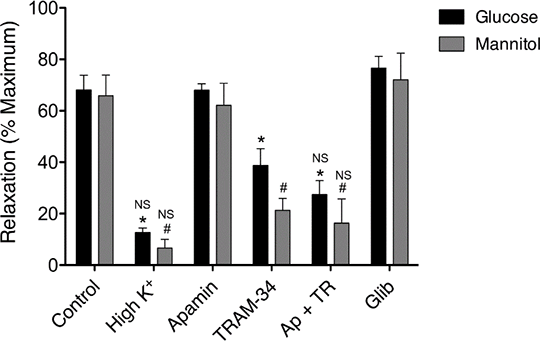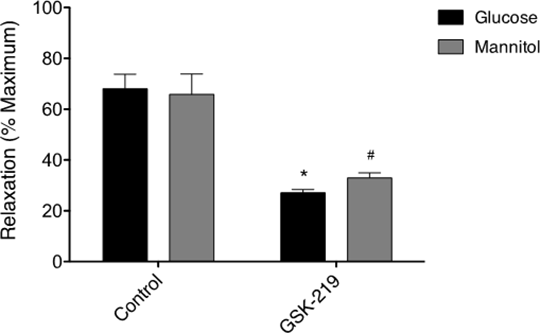A Putative Role For TRPV4 Channels In The Hyperosmotic-Mediated Vasorelaxation Of Mouse Mesenteric Resistance Arteries Hyperosmotic-mediated vasorelaxation (HOMV) has been reported in several vascular beds and TRPV4 channels have been implicated in both endothelium-mediated vasodilation (coupling to intermediate conductance Ca2+-activated K+ (IKCa) channels) (1) and responses to hyperosmolarity (2). The present study aimed to investigate if HOMV can be stimulated in small mesenteric arteries, and to establish the underlying mechanisms. Adult male C57B1/6J mouse mesenteric arteries were mounted in a wire myograph to measure isometric changes in vessel tension. In arteries pre-constricted with phenylephrine (1-5µM), HOMV was found to be endothelium-dependent so 100µM ÊŸ-NAME and 5µM indomethacin were present throughout, meaning relaxation reflects only the opening of endothelial KCa channels. Acute application of 40mM hyperosmotic (HO) glucose or mannitol caused robust vasorelaxation (68.1% ± 6.33, n=6 and 65.8% ± 8.03, n=4 respectively, P<0.05). Inhibition of IKCa channels, but not KATP channels or small conductance Ca2+-activated K+ (SKCa) channels, with 1µM TRAM-34 significantly attenuated HOMV in response to HO glucose and mannitol (38.7% ± 6.60 and 21.4% ± 4.57 respectively, P<0.05, n=3) (Figure 1). Furthermore, inhibition of TRPV4 channels with 1µM GSK-2193874 was associated with a reduction in HOMV (27.1% ± 1.33 and 33.0% ± 1.96 for HO glucose and mannitol respectively, P<0.05, n=3) (Figure 2). Figure 1
Figure 2
These results provide preliminary evidence for the recently characterised endothelial IKCa-TRPV4 functional module in mesenteric HOMV, as well as supporting a HO-responsiveness of TRPV4 channels. HOMV may contribute to various physiological and pathophysiological scenarios associated with the build-up of osmolites in or around resistance arteries (namely vascular changes in diabetes mellitus and functional hyperaemia); defining the underlying mechanisms will help us better understand its role in both health and disease. (1) Zhang DX et al. (2009). Hypertension 53: 532–8. (2) Liedtke W and Friedman JM. (2003). Proc. Natl. Acad. Sci. U.S.A. 100: 13698–703.
|



